Published
on 1
May 2013
|
All rights reserved.
|
|
|
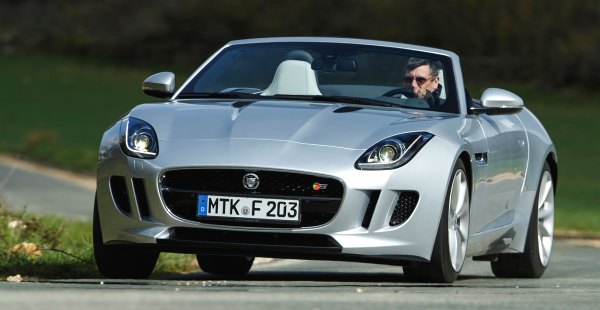
|
F-Type has always
been the missing link in the bloodline of Jaguar sports cars. After
building a handful of C-Type and D-Type for motor racing in the 1950s,
Jaguar turned its vision to a proper road-going sports car. The E-Type set new standards for design and
speed in 1961. It was considered the most important sports car in the
world before the arrival of Porsche 911, and more than 72,000 units
were sold worldwide. Somehow, Jaguar failed to repeat its success in
the subsequent XJS and XK8 as they grew larger and more
luxury-oriented. A couple of attempts to revive the spirit of E-Type
did not materialize – in the late 1980s, a prototype F-Type was built
but it got rejected by new owner Ford; in 2000, a small roadster
concept bearing the F-Type name was unveiled in Detroit motor show.
Again it failed to get production green light. Ironically, the closest
thing to revive the E-Type philosophy was Aston Martin DB7. It was
originally designed by TWR as a proposal for Jaguar. Unfortunately,
Jaguar was not interested at all, so TWR modified the design and built
it for Aston. The rest was history. Incidentally, the guy styled that
car is exactly the same one as today's F-Type: Ian Callum.
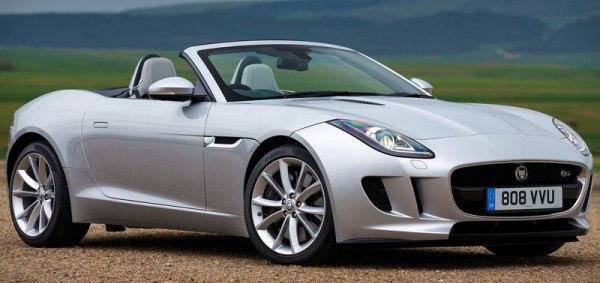 |
Seeing the new Jaguar F-Type, it is easy to understand why Ian Callum
has been highly respected in the circle of automotive design. As
everybody knows, it is no longer possible to replicate the beauty of
1960s in the presence of new safety regulations (hence a high bonnet)
and modern requirements for aerodynamics (hence a high tail). However,
Callum still managed to envelop the boundary better than most other
designers. The F-Type looks remarkably sporty thanks to a wide and
short stance. Its shoulder width is 120 mm broader than that of Porsche
Boxster, while the combined length of its front and rear overhangs is
50 mm shorter. In addition to the monstrous-size 19 or 20-inch wheels,
no wonder it delivers an unusual sense of grip and stability.
Don't get me wrong, it is not just about He-Man muscular. Callum also
injected a great deal of subtlety and elegance into its body surface.
Most notable is the subtle curve extending from the rear fenders to the
slim taillights. It makes the tail look lighter and sleeker than
actually is. In my opinion it is a clever touch to replicate the E-Type
without sacrificing modern functions - well, it does need a tiny pop-up
spoiler to minimize aerodynamic lift, but so does a Porsche Boxster.
The front end is also worth praising. The vertical headlights draw your
attention to the sharp crease lines pressed on front fenders, which are
mirrored by the vertical blades on bumper. The part-rectangular,
part-oval front grille occupies the right position and area. There is a
high level of coordination and harmony achieved among its various
design elements. The result is a car that looks beautiful right at the
first sight and is likely to endure the test of time.
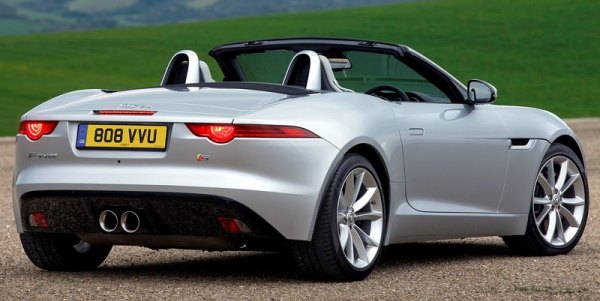 |
Inside, the story is not as remarkable. As I mentioned before (see XK),
Callum doesn't design interior as good as exterior, and this tradition
continues at the F-Type. In my opinion, its instrument pod, center
console and switch gears could be more special. The use of materials
could be classier, especially the plastic gearshift paddles. The
steering wheel doesn't need to be shared with XJ if not for cost
saving. As it is, it doesn't feel as desirable as a Mercedes SL or
Porsche 911 / Boxster / Cayman. Nevertheless, overall speaking it is
still pretty well finished, at least good enough to survive until the
mid-life facelift 4 or 5 years later. In terms of functions, this cabin
works flawlessly. You sit low in the cabin (20 mm lower than the case
of XKR-S), surrounded by a snug environment and supported by a
comfortable seat. Unless you are taller than 6' 3", you will find it
offers enough room. All major controls and switches have a tactile feel.
The luggage space is not so good. There is no space left behind the
seats for hand-carry luggage. The trunk is also small at 196 liters
only, blame to the fact that the battery and water tank for windscreen
washer are packed under the boot to improve weight distribution. If you
play golf, you had better to choose the larger XK instead.
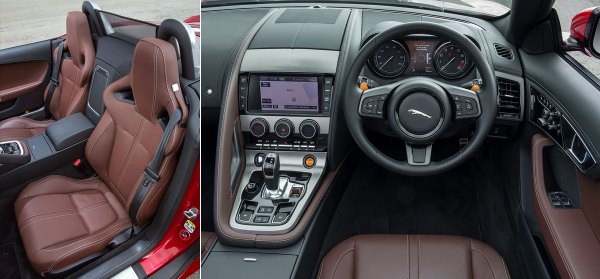
|
Speaking of weight distribution, the V6 versions of F-Type would
achieve a perfect balance of 50:50 with two occupants on board, or a
slightly less desirable 52:48 unloaded. I would prefer a little bit
rear-biased weight distribution, but considering this is a conventional
FR roadster with a front-mounted gearbox, I would say it is pretty
good.
Like XK and XJ (but unlike XF), the F-Type's body is an aluminum
monocoque, comprising of 141 aluminum pressings, 18 high-pressure die
castings and 24 extrusions. The parts are jointed together by riveting
and bonding. Apart from the plastic trunk lid and under-sill
structures, nearly everything is made of aluminum. Unfortunately, the
car still weighs about 250 kg more than the comparable Porsche Boxster
S and 911 Carrera, showing plenty of room to improve in the future. On
the plus side, its torsional rigidity is said to be 10 percent stiffer
than XKR-S, which is evident on the road as it shows no scuttle shake
and flexing at all. The chassis rides on classic double-wishbone
suspensions at all corners. The control arms and knuckles are
constructed in aluminum, of course. Jaguar's adaptive damping and
Dynamic Drive control system is standard except on the cheapest model.
Surprisingly, the steering is still hydraulic-assisted, but it is
geared to 2.5 turns lock-to-lock, which is far more direct than
previous Jaguars.
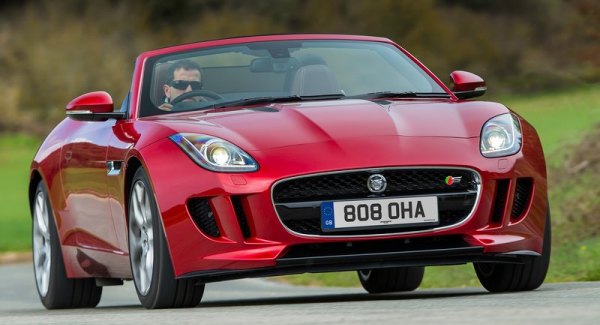
|
There are 3 models to choose from: V6, V6 S and V8 S. We start from the
flagship model first. Its 5-liter direct-injection supercharged AJ-V8
is taken straight from XKR and XFR, just has it maximum output reduced
by 15 hp to 495 hp, probably due to the more restricted exhaust routing
in the smaller engine compartment. Peak torque remains unchanged at 461
pound-foot. As the car is nearly 100 kg lighter than the XKR, its
performance is even more aggressive – Jaguar estimated a top speed of
186 mph (300 km/h), acceleration from 0-60 and 0-100 mph in 4.2 and 8.9
seconds respectively. While I won't use the term "supercar" to describe
it – too many people misuse it these days – it is unquestionably very
fast. How fast? Think of an Audi R8 V10 Spyder, a BMW M6 Cabriolet or a
911 Carrera S in its fastest PDK and Sport Chrono tune. Like all F-Type
models, it employs a compulsory ZF 8-speed automatic. An
electronic-controlled active differential is responsible for splitting
its tremendous power between the rear wheels.
The V6 S model is probably the sweet spot of the three, as Jaguar
implied. Its 3.0-liter supercharged V6 is derived from the AJ-V8, so it
needs counter-rotating front and rear balancer weights to cancel the
end-to-end vibration resulted from its 90-degree V-angle. Like the
AJ-V8, it is equipped with dual-continuous variable valve timing,
spray-guided direct injection and a 4-lobe Eaton TVS supercharger. The
only difference is higher compression ratio (10.5:1 vs 9.5:1), which
should benefit low-rpm delivery. Output is rated at 380 hp and 339
lbft, enough to register 171 mph top speed and 0-60 mph in 4.8 seconds.
In other words, it is about as fast as a Porsche Boxster S PDK. Because
it is not as powerful as the V8, a mechanical LSD is considered
sufficient for the job.
The cheapest V6 model is the detuned version of V6 S. It produces 340
hp and barely less torque at 332 lbft. Performance is not reduced too
much, but to enable a keener price it sacrifices LSD of any kind as
well as the adaptive damping and dynamic drive control system.
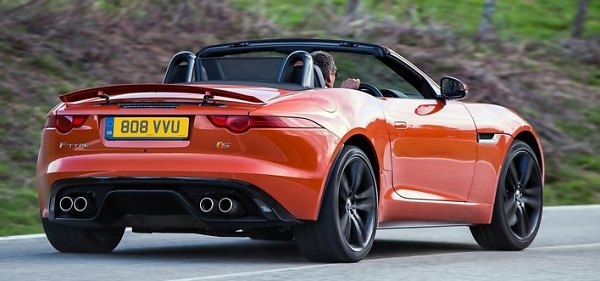
|
Speaking of price, the V6, V6 S and V8 S are sold at just under
£60,000, £70,000 and £80,000 respectively. The V8
hits right to the heartland of Porsche 911 Carrera 3.4, while the V6
duo rests somewhat higher than the level of Boxster S / Cayman S and
somewhat lower than the 911 range. Jaguar calls it a sweet spot in the
market. I call it an excuse to hide the high costs of its bespoke
aluminum construction. The point is, Porsche managed to make the
Boxster S / Cayman S duo lighter without resorting to full aluminum
chassis, faster in the real world without employing forced induction
yet still undercuts the F-Type by a large margin, even after options.
Perhaps the new Jaguar is not as brilliant as it first appears.
Road tests confirm my suspicion. In isolation, the F-Type is really fun
to drive. The V6 S offers plenty of pulling power and a throttle
response matching a normally aspirated motor. Its exhaust note sounds
pretty special when the bypass valve opens to a crackling overrun. The
ZF auto responds quickly and smoothly, so the car is easy to drive fast
as well as to cruise on highway. In Dynamic mode, the suspension feels
taut and the chassis feels well balanced. Approaching limit, it
understeers gently. Keep pushing, it runs into a mild oversteer, which
is easy to correct. The quick steering adds to the sense of agility.
This car is definitely sportier and more fun to drive than the likes of
Mercedes SLK55 or SL500.
However, when compared against a Porsche Boxster S or 911 Carrera, you
will find it lags behind in many areas. For example, the Porsche's
flat-six is smoother, more willing to rev and sounds even more exciting
when being stretched. The PDK gearbox reacts keener to driver's input.
In terms of ride and handling, there is no comparison. The Porsches
feel lighter and more agile thus they are more precise to control in
the twisty. They also ride better on rough surfaces. Strangely, the
Jag's hydraulic steering does not offer more feel than Porsche's
electrical rack. In fact, the latter feels more communicative at times.
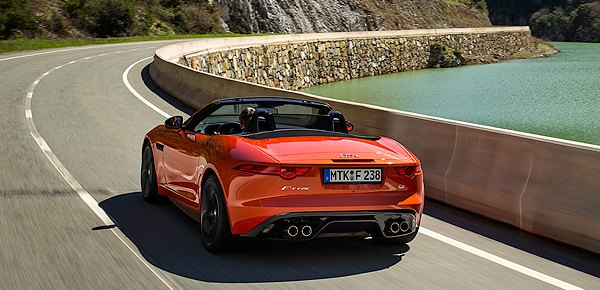
|
The lesser V6 model is slightly less enjoyable because it lacks the
sportier exhaust note of the V6 S, while the passive dampers return a
firmer ride on poor roads.
Meanwhile, the V8 S is a very different animal – it is virtually a
beast! The V8 sings a lot crazier and provides a completely different
level of performance. The way it accelerates between bends is brutal.
In fact, its tremendous power seems too much for the chassis to cope
with at times. The chassis balance is not as good as the V6 S due to
the extra 30 kg over the front axle. Such weight also makes its
steering weightier and less sensitive. If you drive without
self-discipline, you can easily overwhelm its balance and grip. When
its tail breaks away, it oversteers quite dramatically, so the
electronic safety net is absolutely necessary to turn on. This is a
modern hot-rod, something that can be as exciting as it is scary. It
reminds us the late TVR.
The F-Type might not be as perfect as Porsche, but it is no less
attractive. It looks stunning beautiful. It goes fast, it drives good
enough and it has its own character. The sports car world will be more
interesting with its presence.
|
Verdict:     |
| Published
on 27
Mar
2014 |
All rights reserved.
|
|
F-Type Coupe & F-Type R
|
|
Beautiful, advanced and
fast, Jaguar F-Type roadster enjoys a good start and helps the
renaissance of Jaguar. However, as I pointed out last year, in
dynamic aspect it still lags behind Porsche Boxster, Cayman and 911 by
considerable margins. Perhaps the new F-Type Coupe could reverse the
situation. By sealing the bath tub with an aluminum roof or
panoramic glass, its chassis torsional rigidity is lifted by 80
percent to 33,000 Nm/degree (though Cayman is even more impressive at
40,000+
Nm/degree), allowing the double-wishbone suspensions and
hydraulic-assisted steering to work as they
originally intended to. It also allows front and rear springs to be
stiffened by 4 percent to sharpen handling further.
Such changes might
sound subtle, but in reality the difference is huge. The F-Type Coupe
turns far sharper, keener and more precise than the coupe. Its steering
feels more direct and communicative, finally as good as a hydraulic
rack should
be. The ride might be firm – probably
too firm for a Jaguar – but it
overcomes speed bumps crisply thus
rarely unsettles the handling. Body control is even better, with little
roll and pitch to speak of. Understeer and oversteer are better
suppressed, too, thanks in no doubt to the better use of suspension
geometry.
This is what the F-Type should have been from the outset. In other
words, its full potential is finally released!
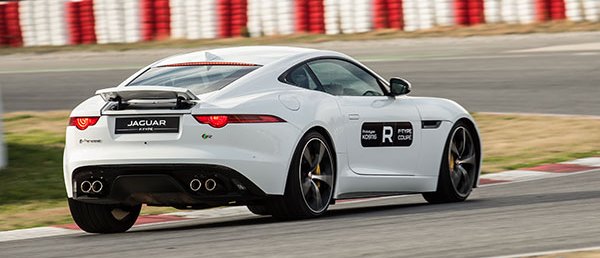
|
As before the 3-liter supercharged V6 in either 340 hp or
380 hp tunes will contribute to the majority of sales, but by far the
most exciting has to be the new range-topper, F-Type R. It adopts the
550 hp version of the 5.0-liter supercharged V8 from XKR-S thus is 55
hp stronger than the V8 S Roadster. While the
V8 Roadster has more grunt than its chassis can handle, the R Coupe
does not suffer from the same problem. Yes, its driving experience is
still dominated by the engine, no matter from the mad exhaust or the
breathtaking acceleration (0-60 takes only 4 seconds flat! while
top speed is governed at 186 mph). With so much power and torque
available from a wide band, you can effortlessly slide its tail in any
bends and at any gears. It is still some kind of a hot rod and needs
your respect, but now the combination of stiffer
chassis, improved grip and a second generation active differential,
which works in
conjunction with torque vectoring by braking, allows you to control its
power slide at will, hold the slide at your desired angle and for as
long as you want. Not just one bend, you can slide through a series of
S-bands in succession without
sweating, a testament of brilliant chassis balance. Not even a Porsche
911 can manage power slide so well! This mean, although
the Jaguar is more engine-led than Porsche, it is even more
exciting to drive – just in a raw way.
All out, the F-Type R recorded a Nurburgring best of 7:39, a second
quicker than 911 Carrera S. The Porsche does beat the
Jaguar in terms of ride comfort and cabin quality, but the Jag strikes
back in exterior design. Both are priced at
about £85,000. Jaguar finally has something to match the mighty
911!
|
Verdict:      |
Published
on 28
May 2015
|
All rights reserved.
|
|
F-Type AWD, manual.
|
|
Although
its sales numbers are still modest, Jaguar shows many good signs about
its future. Its F-type and XE generate strong
interests and steady increase of income. Profits (and more investment
from Tata) is fed back to improve its cars, which will increase its
income again. When the F-type was launched 2 years ago, its line-up was
limited to a convertible body, one transmission and 3 engines, much
simpler than its Porsche rivals. Last year, coupe body and F-type R
were added to the choices. This year, its customer portfolio gets
broader again with the introduction of AWD and manual transmission.
The AWD system uses a center coupling with multi-plate clutch, located
behind the ZF 8-speed automatic transmission, to engage the front
differential. As the front prop-shaft goes through the engine sump, the
engine needs to be raised by 10 mm compared with the RWD model, and
this in turn requires a slightly reshaped bonnet to accommodate.
Normally, the F-type is driven purely by the rear wheels. In case the
rear wheels slip, computer will signal the center coupling to engage
the front axle, which could get up to 50 percent of all torque. This
means, the F-type AWD keeps the rear-biased sporty handling most of the
time, but at the limit it finds extra traction and security. Sounds
very much like Nissan GT-R. In reality, the system also works very
well. If you live in the snowbelt or you can't stand the tail-happy
character of the original car, especially the 550 hp F-type R, the AWD
will be a perfect choice. To keen drivers, however, the highly playful
RWD model is still the definitive choice. It is also 80 kg lighter and
has a slightly lower center of gravity, so its handling is slightly
sharper. Moreover, the car already got safety nets in the form of
stability control, torque vectoring by braking and active differential.
Another addition, if less significant to most customers, is a 6-speed
manual gearbox. If comes from ZF, no wonder the gearshift is so
familiar. Shift quality is generally good, if not as good as the best
Japanese gearboxes. What it adds is not speed but driver involvement.
It must be said that the manual gearbox cannot be matched with AWD, as
it would be too costly to develop considering the small demand. The AWD
and automatic combo is different, because it will be used in larger
scale by XE and XF.
Apart from these changes, the F-type has some revisions this year. Like
XE, it gets the company's first ZF electric power steering system,
replacing the old hydraulic setup. Does it hamper communication from
the front wheels? No, on the contrary. Remember, the old steering was
never renowned for feel (see our original review), so the new rack
actually improves on that, plus it is more precise. A welcomed
improvement.
With the introduction of 550 hp F-type R Coupe, some questioned why the
V8 S convertible still ran a 495 hp motor. That's why Jaguar has
finally replaced the latter with F-type R Convertible. Mind you, the
Coupe's stiffer chassis always makes better use of the huge horsepower
advantage. The open-top is more romantic, but it is more suitable to
the lesser V6s.
|
Verdict:     |
| Published
on 18
Jun
2016 |
All rights reserved.
|
|
F-Type SVR
|
|
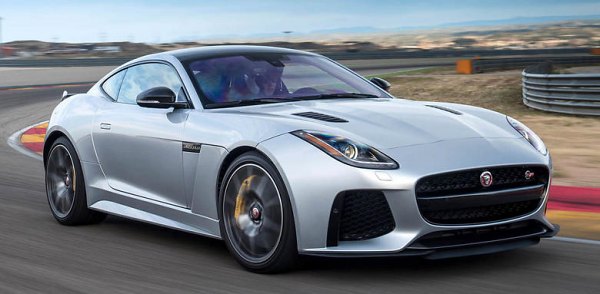
|
Sometimes I wonder what
market position Jaguar F-type aims at. Originally it was conceived to
rival Porsche Boxster/Cayman in the region of £50,000, which was
a nice fit below the larger and more expensive XK. But then the XK
retired, and Jaguar started stretching the smaller car to cover higher
and higher segments. A couple of years ago, F-type R lifted it to the
level of £85,000, with performance to match. Now with the
involvement of Special Vehicle Operations (SVO), the new F-type SVR
takes the fight to an even higher segment. It asks for an eye-popping
£110,000. In return, you get equally eye-popping performance,
say, 0-60 mph in 3.5 seconds and a genuine 200 mph top speed. The fact
that it is the fastest Jaguar since XJ220 may not touch you, but what
really makes a point is that it is the cheapest 200 mph sports car you
can buy in Europe, and that title is expected to cover globally when
the 205-mph Dodge Viper dies next year. For a similar ticket to the
200-mph Club, you need to buy a Porsche 911 Turbo S (£145,000),
Porsche 911 R (£137,000), Aston Martin V12 Vantage S
(£138,000) or Audi R8 V10 Plus (£135,000), although Nissan
GT-R and Mercedes-AMG GT S get very close.
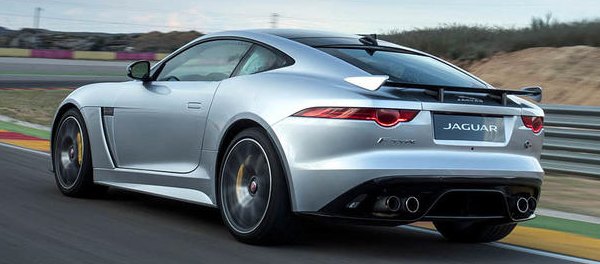
|
The question is, can the car originally designed to the
standard of £50K deliver the necessary dynamics and refinement to
meet the expectation for a £110K, 200-mph machine? SVO has its
work cut out. The SVR is modified based on the F-type R AWD to take
advantage of its extra traction. Its supercharged 5-liter V8 gets
remapped ECU and a freer flowing titanium-Inconel exhaust to extract
another 25 horsepower, making a total of 575 hp. Peak torque is also
lifted slightly to 516 pound-foot. The ZF 8-speed automatic
transmission is recalibrated to speed up gearshifts a little. Yes, all
these sound not much compared with the already high baseline, so SVO
also tries to cut some fat from the car. The aforementioned exhaust
alone is 16 kg lighter. In addition to lightweight forged alloy wheels
(13 kg) as well as the optional ceramic brakes (21 kg), and
carbon-fiber roof (4 kg), the whole car is 50 kg lighter. However, this
is by no means a GT3 alike. Its interior retains all the leather and
equipment so that it feels properly luxury in the usual Jaguar way.
After all, a stripped-out cabin would make little difference to a car
already weighing 1.7 ton.
As the power boost is rather small, to enable the 200 mph top speed the
SVR needs to reduce drag. Its nose is reshaped to include a deeper and
wider lip spoiler to mask more of the front wheels. The additional
vents aft of the front wheels release pressure built inside the engine
compartment yet help engine cooling. The latter is also improved by
larger intakes and redesigned bonnet louvers. The new under-floor tray
smoothes air flow underside and feeds the new diffuser. As the new
exhaust features 2 longitudinal silencers instead of a single
transverse silencer, a deeper venturi can be built between the
exhausts, enhancing the effectiveness of diffuser. However, the most
obvious change is the addition of a tail spoiler, which makes the SVR
look significantly more striking than other F-types. It seems to be
fixed, but actually can rise and extend rearward at above 70 mph, just
not retractable into the body. Overall, Jaguar said aerodynamic lift is
reduced by 45 percent when the spoiler is extended, whereas drag is
reduced by 7.5 percent when the spoiler is lowered.
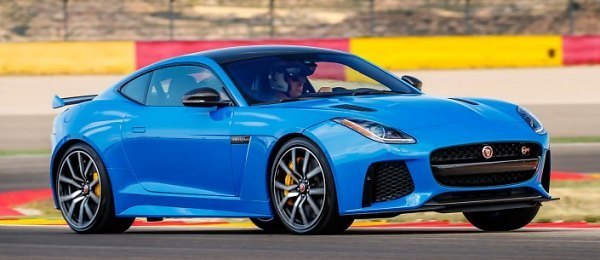
|
However, on the road it is difficult to tell if the SVR is
any more powerful than the F-type R. The extra power is too small, and
the exhaust note, though a little more hard-edged, does not make a big
difference. After all, the F-type R is already hugely powerful and
accompanied with one of the most dramatic exhaust noise. Likewise, the
gearbox might be a little quicker to change ratios, but it is not
different enough to make a strong impression. What you can tell is the
car does afford better traction off the line, thanks to a set of wider
tires. Don’t get me wrong, the SVR is very fast in straight line. It
might be even quicker than the official 0-60 mph time of 3.5 seconds
suggested. 0-100 mph should start with a “7”, faster than any Aston
Martins. Faster than even an XJ220 actually. The problem is, its power
delivery, sound and transmission response are all too familar to the
F-type R, so subjectively it doesn’t feel remarkably faster. The extra
top speed is rarely accessible on public roads.
Comparatively, changes to the chassis are more noticeable. Both front
and rear wheels get slightly wider Pirelli P Zero tires with bespoke
compounds. The suspension is beefed up as well. While springs are
unchanged, the dampers and anti-roll bars have been retuned. The
anti-roll bar up front is softened while the rear gets stiffer, so the
car affords better front-end grip and therefore reduces understeer.
Stiffer rear knuckles reduce camber change in hard cornering thus
enhance grip and traction. In addition to a retuned power steering, the
SVR feels pointier, sharper on turn-in and more neutral at the limit.
Like Ferrari but unlike Aston, its quick-ratio steering in combination
with the sharper turn-in could feel nervous in the beginning. Spend
enough time with the helm and you will eventually get used to it,
feeling confident with your subtle inputs.
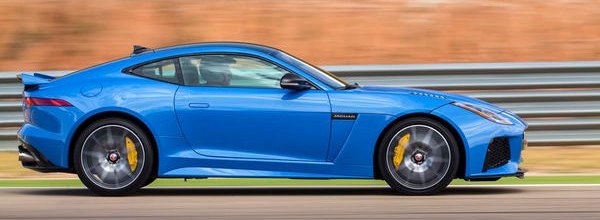
|
Ride quality remains quite stiff at low speed, but it
improves dramatically at speed. Overall, it rides slightly better than
the F-type R.
With AWD fitted mandatorily, the SVR feels a lot more secured when
being driven hard in the twisty. There is much less movement at the
tail as the AWD system reshuffles torque to the front axle when the
rear spins. You can still induce power slide by using its deep reserve
of torque, but the slide is now more benign, fully under control,
unlike the rear-drive F-type R which could give you some scary moments.
The SVR gives you great confidence thus allows you to access its
performance deeper.
Good though the SVR is, there are many cars at this price being
lighter, more agile and just as quick in the real world. Some of them
are thoroughbred sports cars and many of them feeling more special. The
SVR is no ordinary, but when you can have an F-type V6 for fifty grand,
you deserve more with £110K.
|
Verdict:     |
Published
on 1
Mar 2020
|
All rights reserved.
|
|
F-Type 2020 facelift
|
|
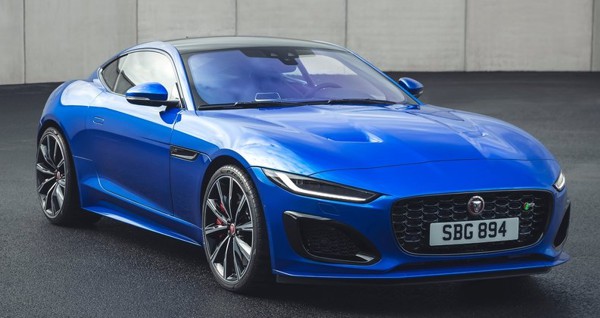
|
|
A
late mid-life facelift keeps the Jaguar sports car on the radar of
buyers.
|
|
Yes, Jaguar sells only a
few thousand F-types a year, but its importance is more than sales
numbers. Without a halo sports car, Jaguar would not be Jaguar. It
would be
just another Lexus, Infiniti or even Volvo. The lineage from XK120 to
E-type to XJS to XK8 to F-type is an inseparable part of Jaguar’s
heritage. I hope it will keep the line forever, even though crossovers
and electric cars seem to be the future.
The F-type has been around for 7 years. If it was as successful as
Porsche, it would have been updated to a new generation by now. As it
is not, and Jaguar is not in very good shape, a facelift is probably
more sensible. Jaguar design boss Julian Thompson takes an approach
different from his predecessor Ian Callum. He makes the car look
sleeker by means of slimmer headlamps, which flank laterally instead of
longitudinally. As a result, the bonnet looks longer and flatter, and
the car appears larger, more like a successor of XK. The brake ducts
are also made simpler. Overall, the front end looks purer, although I
still prefer the original shape. Nothing is changed at the back, save
the body-colored diffuser.
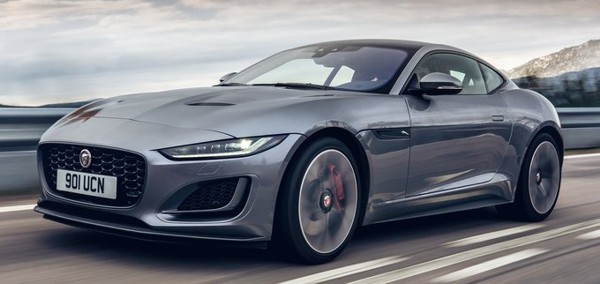
|
|
The
nose looks purer and sleeker, though I still prefer the old look.
|
|
All F-type models save the range-topping R have been renamed to reflect
horsepower. The entry-level model is called P300. It employs the
Ingenium 2.0-liter four-cylinder turbo with continuous variable valve
lift technology. Output is 300 hp, of course, allowing the car to go
from 0-60 in 5.4 seconds. Sadly, it is slower than a 718 Cayman, and it
costs the same as a similarly equipped Cayman S. The F-Type is just too
heavy, shameful for a car constructed out of aluminum. Although the
P300 is the best handling F-Type due to its lighter nose, it is no
match for a mid-engined Porsche. For a conventional FR sports car,
however, it is undeniably good, thanks to feelsome steering and a good
ride and handling balance.
The 380 hp supercharged 3-liter V6 still serves America under the new
name P380, but it is falling out of favour in Europe due to the drive
to cut CO2 emission. Instead, European
customers get a detuned version
of the 5-liter supercharged V8. Dubbed P450, you know the output rating
already. It fits well between the four-cylinder model and the F-Type R
with a price of £70,000. Yes, it is slower yet more expensive
than
a Cayman GTS, but that doesn’t matter much, because V8 power is the
dream of many car lovers. No wonder Jaguar said it is the sweet spot of
the range.
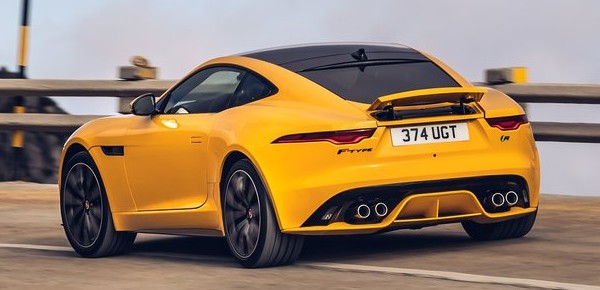
|
|
F-Type
R gets more power and some desperately needed suspension improvement.
|
|
At the top is the F-Type R, now with compulsory AWD. It runs the same
V8, just at a much higher state of tune. 575 horsepower represents a 25
hp improvement over the last one, but it is actually the same motor as
in the discontinued SVR. £97,000 is a lot of money from any
perspective, but at least it is cheaper than the SVR. The F-Type R used
to be some kind of a hot rod. It was all about mega power, whereas the
chassis sometimes failed to control that power. Therefore, this time
Jaguar has its suspension modified using the knowledge learned from the
SVR and XE SV Project 8. New suspension uprights, ball joints and wheel
bearings increase negative camber and toe stiffness, maximizing tire
contact patch under hard cornering. Springs and anti-roll bars have
been uprated, while tire sizes grow by 10 mm. As a result, the car puts
down the power more effectively, being less tricky to handle under
stress. The power steering of the R is also recalibrated to be a bit
slower, so to make it less likely to unsettle the rear axle. The F-Type
R is no 911, blame to its weight and the way its weight distributed,
but for an FR car it still has its mass well controlled, while the ride
is still good. The R rewards you with a glorious noise, although
exhaust crackles on the overrun has been toned down a bit to make it
more friendly to others. The power delivery of the supercharged V8 is
linear, throttle response is immediate. The power feels insane from
3000 rpm, and the 8-speed automatic upshifts with an urgency – and a
forceful kick – unfamiliar with other ZF siblings. It feels exciting.
Apart from price, the weakness of F-Type remains to be its interior,
which feels a little outdated and cheap for a car at this price.
Jaguar did improve it with a new TFT instrument and updated
infotainment, but the latter remains quite rubbish. All these changes
might not boost too much sales, but they keep the sports
car line alive and remind us there are decent alternatives to Porsche.
|
Verdict:     |
|